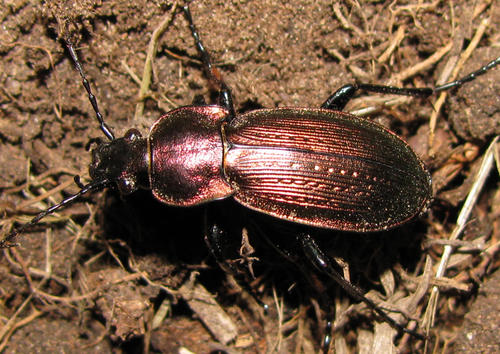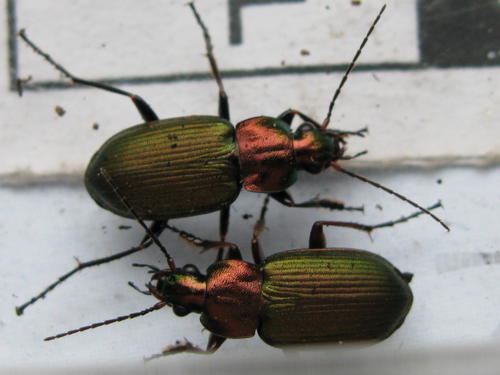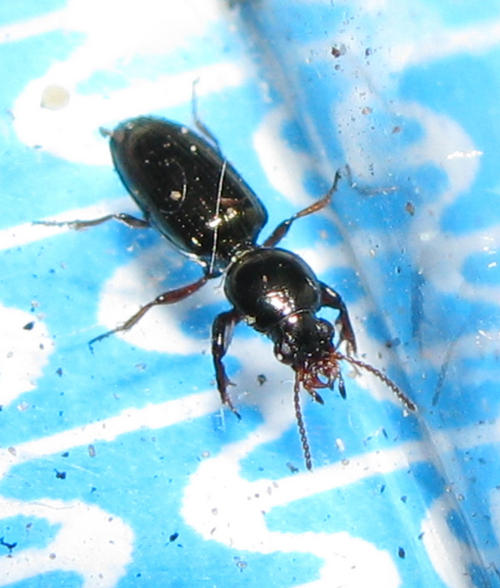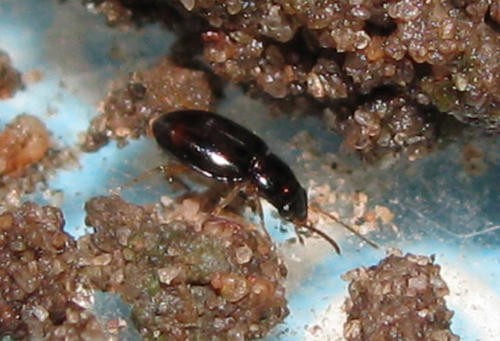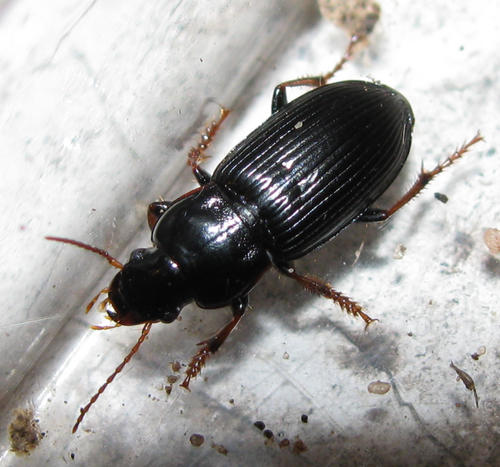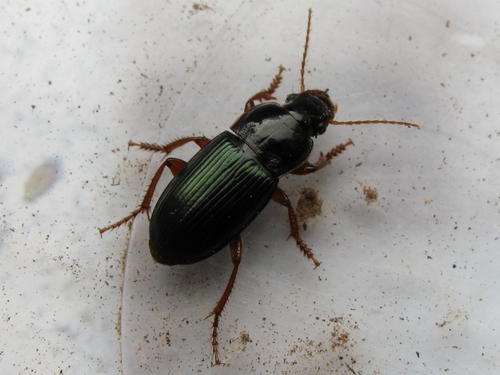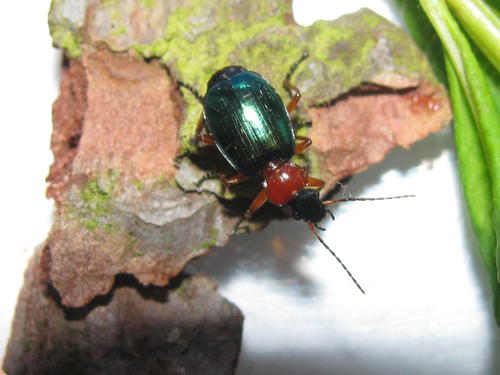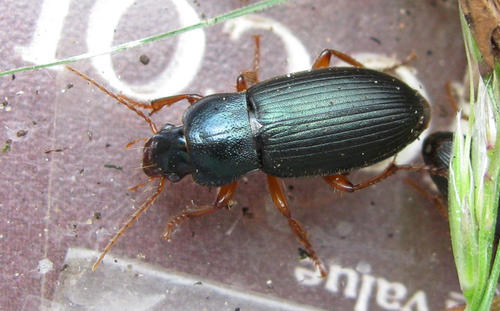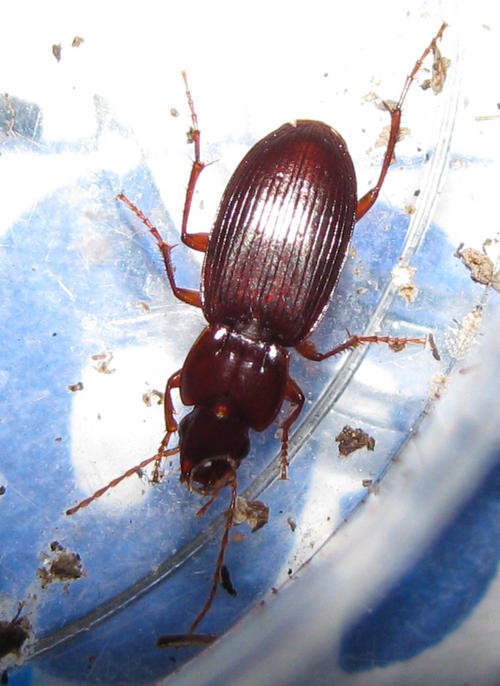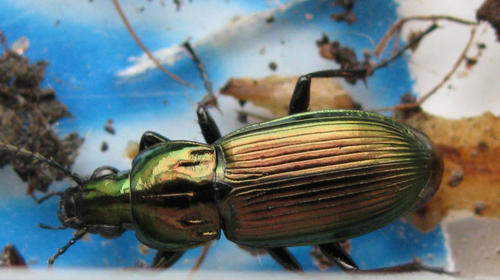Carabidae of note 2009-2010 in the Kidderminster and Bewdley area
Alan Brown
At the beginning of 2009 I was asked to do a carabid survey by John Meiklejohn in the Kidderminster and Bewdley area, which is still ongoing. I used a night hunting tactic with a powerful LED headband torch. The more notable finds are listed below and all were found at night. Good detailed digital photographs are available.
[All species are pictured except two: Bradycellus caucasicus & Badister unipustulatus. The text on each species is included with with its picture also. The pictures are in alphabetic order, down left column below, then down right column. (Web page edit)]
Ophonus laticollis: (Notable A): 27.05.2009. My best find! There have been only two other recent records in the county. I found 15 of these on a dry, sandy grass strip at the base of an old hedgerow next to an arable field, Kidderminster.
Carabus monilis (Notable B): 20.06.2009. I found five of these in a recently cut grass meadow on dry, sandy soil, but I have regularly found them on roadside grass strips, Kidderminster.
Calathus ambiguus (Notable B): 31.08.2009. I found six of this rare Carabid on a bare, sandy arable field, Kidderminster.
Poecilus lepidus (Notable B): 21.06.2009. A heath specialist. I found these in good numbers on the Devil’s Spittleful NR. They were on bare, sandy ground near Calluna.
Harpalus attenuatus (local): 21.03.2010. Normally a coastal species. I found a healthy number of these on sandy ground on the Devil’s Spittleful NR.
Harpalus smaragdinus (Notable B): 17.04.2010. Another heathland specialist. I found a strong population of this very local Carabid at the Devil’s Spittleful NR.
Amara equestris (Notable B): 08.06.2009. Another very local carabid. I first found these in small numbers on the sandy fringes of roadside grass strips but later I found a larger population at the Devil’s Spittleful NR.
Amara anthobia (local): 15.04.2010. An introduced species reportedly found on bare sandy ground. I found this one hiding under grasses on a roadside grass strip, Kidderminster.
Amara fulva (Notable B): 25.05.2009. I found this Carabid on bare, sandy arable fields, and also in good numbers at the Devil’s Spittleful NR.
Amara consularis (Notable B): 15.04.2010. This Carabid I found in good numbers on two particular bare, sandy, arable fields, but nowhere else. Soil composition seems to be important with this one. Kidderminster.
Bradycellus caucasicus (local): 17.04.2010. [no picture] Associated with Calluna heathland but more local in the south. I found these in small numbers on the Devil’s Spittleful NR.
Lebia chlorocephala (Notable B): 28.06.2010. I found this handsome Carabid by “staking out” a small population of the leaf beetle Chrysolina varians at the Devil’s Spittleful NR. I saw a second specimen on 02.07.2010.
Elaphropus parvulus (Notable B): 06.06.2010. Often associated with areas of human disturbance. I found this tiny Carabid in a damp, sandy furrow of an arable field. Kidderminster.
Dyschirius politus (local): 13.06.2009. I found this one on a damp, stony pathway through a meadow but since I have found it in good numbers in damp furrows on arable land and on bare sand alongside the river Severn, Kidderminster and Bewdley.
Platyderus depressus (Notable B): 19.04.2009. I first found this Carabid on a sandy grass meadow at Springfield Park but since then I have also found them in good numbers on dry roadside grass strips. Kidderminster.
Chlaenius nigricornis (Notable B): 10.04.2009. A marsh specialist I found a small number of this Carabid on bare, muddy ground at Puxton Marsh, Kidderminster.
Blemus discus (Notable B): 24.07.2009. [no picture] I found a small population of these on bare, silty ground alongside a stream running through Puxton Marsh, Kidderminster.
Badister unipustulatus (Notable B): 10.03.2009. [no picture] I found six of this local Carabid alongside another beetle (Badister sodalis) under leaf litter on the edge of a shaded willow carr bog on Springfield Park, Kidderminster.
Bembidion quadripustulatum (Notable B): 13.07.2010. I found four of this very local Carabid on a sandy area of a shingle bank alongside the River Severn at Bewdley.
Bembidion bipunctatum (Notable B): 11.07.2010. I found six on the same shingle bank, but this one seems to like hiding under the shingle itself, Bewdley.
Bembidion obliquum (Notable B): 30.07.2010. Found in various habitats near still water. I found this one on a bare patch of mud alongside a small pond, next to the river Severn at Bewdley. Very similar to Bembidion varium
Acknowlement
I would just like to thank John Meiklejohn for confirmation of all the listed Carabid species that I have recorded.
Comment by John Meiklejohn
All the records in Alan’s list have been passed to the WBRC with the requisite grid references, dates and habitat notes together with many more for more common carabid species. What has surprised me is the number of individuals of the uncommon species that Alan’s technique has revealed. I was so impressed with his findings that I acquired a head lamp and ventured into my garden here in Defford after midnight. I was surprised at the number of beetles, and slugs, that are active in the dark. Unsurprisingly my beetle finds were numerous common carabids such as Pterostichus madidus and Harpalus rubripes. Alan’s main hunting grounds are in the Kidderminster area, Devils Spittleful, Hartlebury Common, shingle banks of the R. Severn, areas with heathland, habitats not common in Worcestershire as whole. He tells me that he is often out until three or four o’clock in the morning. I must get down to the local brook in the early hours!
It is good to hear of a different species hunting techniques: pit-fall trapping, litter sieving, tussocking and now night time torching! Moths come to lights, beetles are revealed by them.
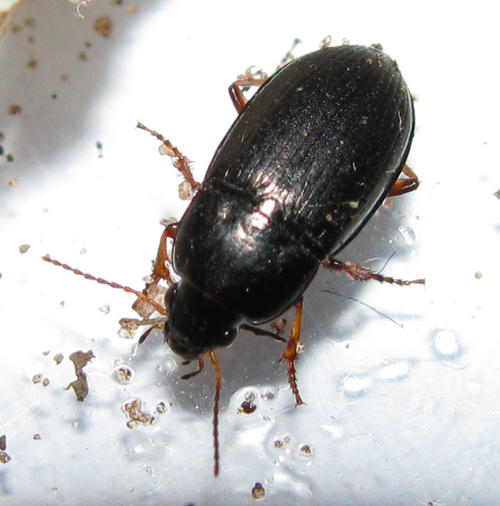 |
| Amara anthobia (local): 15.04.2010. An introduced species reportedly found on bare sandy ground. I found this one hiding under grasses on a roadside grass strip, Kidderminster. |
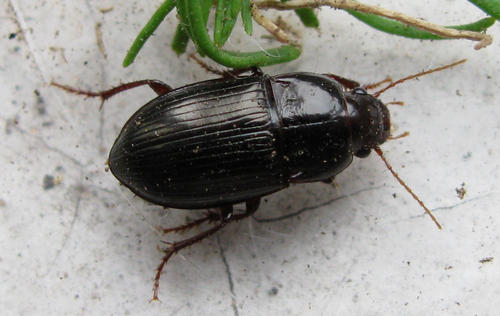 |
| Amara consularis (Notable B): 15.04.2010. This Carabid I found in good numbers on two particular bare, sandy, arable fields, but nowhere else. Soil composition seems to be important with this one. Kidderminster. |
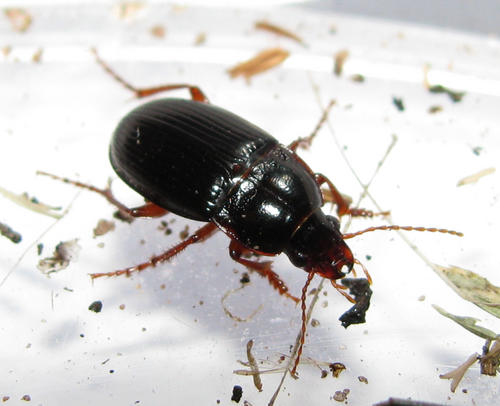 |
| Amara equestris (Notable B): 08.06.2009. Another very local carabid. I first found these in small numbers on the sandy fringes of roadside grass strips but later I found a larger population at the Devil’s Spittleful NR. |
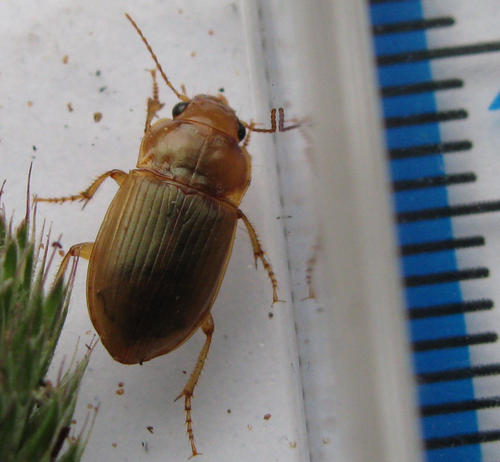 |
| Amara fulva (Notable B): 25.05.2009. I found this Carabid on bare, sandy arable fields, and also in good numbers at the Devil’s Spittleful NR. |
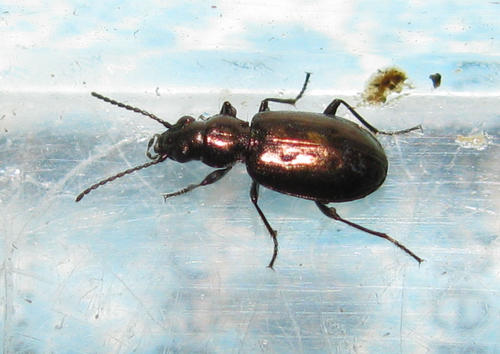 |
| Bembidion bipunctatum (Notable B): 11.07.2010. I found six on the same shingle bank, but this one seems to like hiding under the shingle itself, Bewdley. |
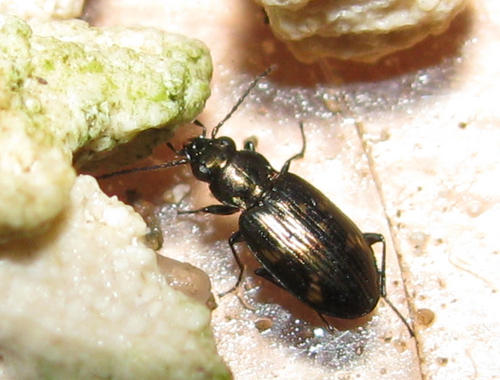 |
| Bembidion obliquum (Notable B): 30.07.2010. Found in various habitats near still water. I found this one on a bare patch of mud alongside a small pond, next to the river Severn at Bewdley. Very similar to Bembidion varium |
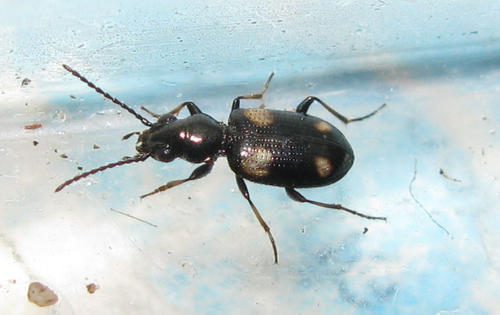 |
| Bembidion quadripustulatum (Notable B): 13.07.2010. I found four of this very local Carabid on a sandy area of a shingle bank alongside the River Severn at Bewdley. |
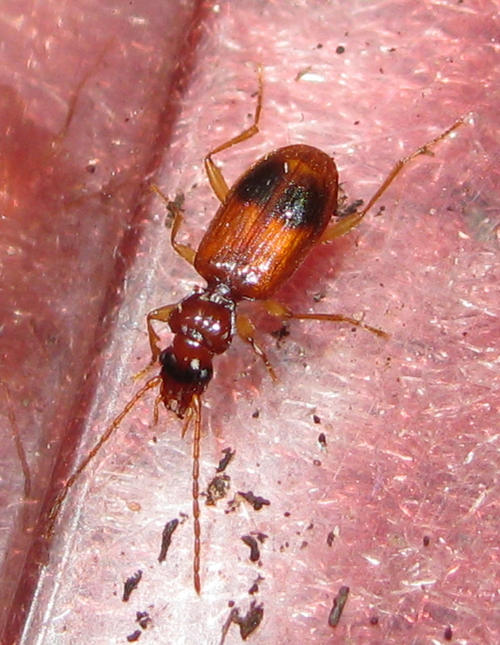 |
| Blemus discus (Notable B): 24.07.2009. I found a small population of these on bare, silty ground alongside a stream running through Puxton Marsh, Kidderminster. |
